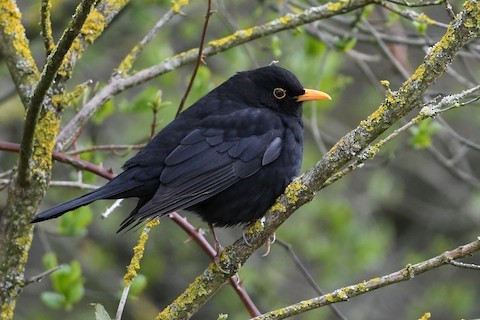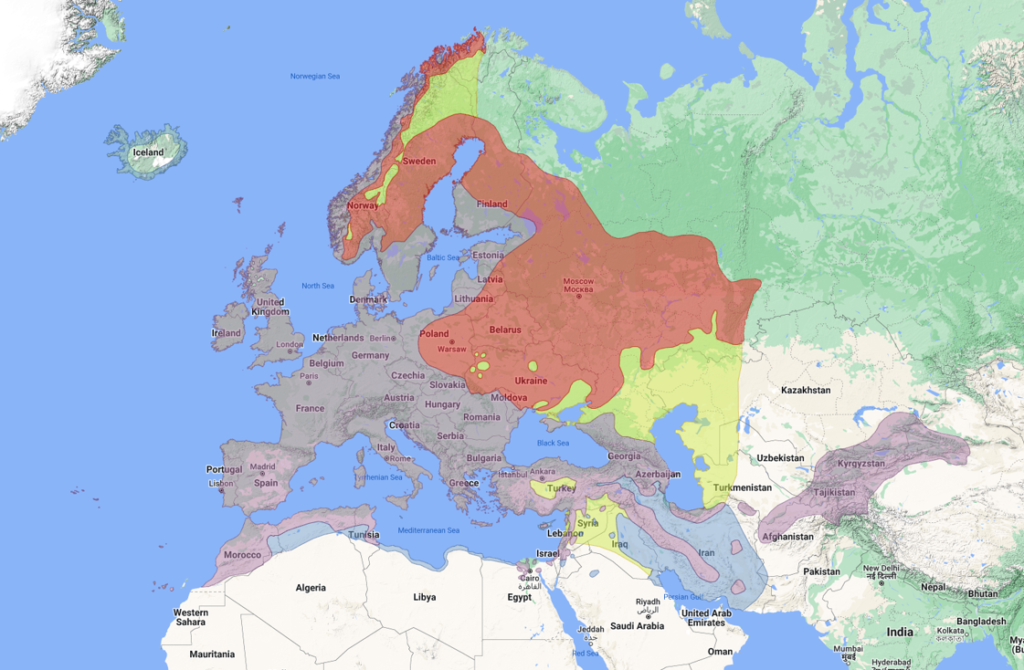Birdfinding.info ⇒ An abundant and familiar garden bird throughout Europe, often seen in cities throughout the continent feeding on lawns or singing from prominent perches. Also abundant in much of its introduced range in southeastern Australia, Tasmania, and nearly throughout New Zealand.
Common Blackbird
Turdus merula
Western Palearctic, in all types of woodlands and semiopen habitats, including agricultural and settled areas. Introduced to Australia and New Zealand.
Breeding. Nests abundantly in various kinds of woodlands—including the full spectrum of evergreen, mixed, and deciduous forests, riparian corridors, urban parks and gardens, savannas, and other semiopen landscapes with scattered trees—throughout Europe north to Finnmark, south to the Mediterranean region of North Africa and Israel, west to Iceland, the Azores, and the Canary Islands, east in the taiga region to the southern Ural Mountains, and in mountainous regions of southwestern and central Asia east to western Mongolia.
In North Africa, breeds widely in the wooded and settled portions of Morocco, northern Algeria, and northern Tunisia, and locally or sporadically in neighborhoods of Cairo. In the Middle East, breeds in the Mediterranean zone of Syria, Lebanon, Israel, and adjacent Jordan.
Elsewhere in Asia, breeds extensively throughout Turkey, the Caucasus, Transcaucasia, and northern Iraq eastward through the northern and southern mountains of Iran, and adjacent lowlands around the southern end of the Caspian Sea. From northern Iran, its breeding range continues locally eastward through mountainous portions of the central Asian republics, southeast at least sporadically to northern Pakistan, and northeast across northern Xinjiang into western Mongolia.
Movements. In winter, it generally withdraws from eastern Scandinavia and most of the Russian interior, but some portion of the population remains in most of its breeding range, including coastal regions and settled areas north to Iceland and Finnmark. Substantial numbers disperse southward into the Mediterranean region, with small numbers occurring south to Egypt, Iraq, and the Persian Gulf lowlands.
Most montane populations of southwestern and central Asia are essentially sedentary, but move downslope in winter.
Despite its evident tendency to disperse across oceans, there are very few confirmed North American records: Montreal, Quebec (1971); Erieau, Ontario (April 12, 1981); Bonavista, Newfoundland (found dead on November 16, 1994).
Introductions. There are well-established introduced populations in New Zealand, southeastern Australia, Tasmania, and several oceanic islands, including Lord Howe, Norfolk, the Chathams, the Aucklands, and Campbell. Reportedly first introduced to both New Zealand and Australia in 1862.
In New Zealand, widespread throughout both North and South Islands and on all suitably vegetated adjacent islands. In Australia, it occurs throughout Victoria and Tasmania (including the Bass Strait islands), west to southeastern South Australia and north through most of New South Wales to southeastern Queensland.
Identification
A robust thrush that is among the most familiar birds of Europe, often seen feeding on open ground, including urban lawns. The male is distinctive and instantly recognizable, with entirely coal-black plumage and a yellow (sometimes orange) bill and orbital skin.

Common Blackbird, male with typical coloration. (Los Prados, Ronda, Málaga, Andalucía, Spain; February 23, 2022.) © Santiago Caballero Carrera
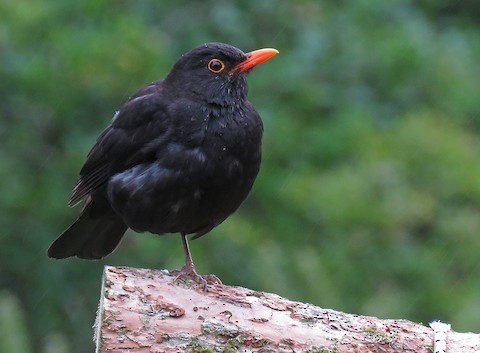
Common Blackbird, male with orange bill and eyering. (Underhill Farm, Peak District National Park, Staffordshire, England; July 29, 2018.) © Dominic Garcia-Hall
Female plumages are plain but highly variable, with some regional tendencies. Most females are predominantly grayish-brown, palest on the throat, with darker streaks and spots that are typically strongest on the throat and chest. The female’s bill is usually yellowish, but often duller than the male’s.

Common Blackbird, female with typical grayish-brown coloration. (Cerro del Telégrafo, Rivas-Vaciamadrid, Spain; May 12, 2021.) © Juan Miguel Artigas Azas
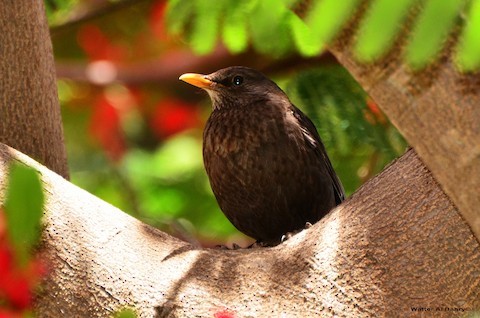
Common Blackbird, female at the dark end of the spectrum. (Al Jizah, Egypt; June 10, 2020.) © Watter AlBahry
The darkest females are blackish. Paler females may appear various shade of gray, brown, and grayish-brown overall—often with darker wings and tail and sometimes with a rusty wash on the breast.
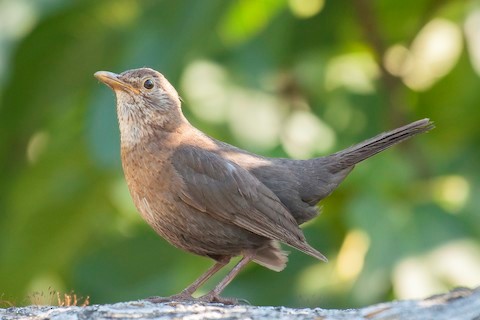
Common Blackbird, female with atypically strong contrast, a whitish throat and cinnamon chest. (Abbaye de Saint-Antoine, Rhône-Alpes, France; July 9, 2018.) © Etienne Artigau

Common Blackbird, female with lead-gray coloration. (Maksimir Park, Zagreb, Croatia; January 1, 2010.) © Bojan Bencic
Immatures resemble adults, but with dark bills.
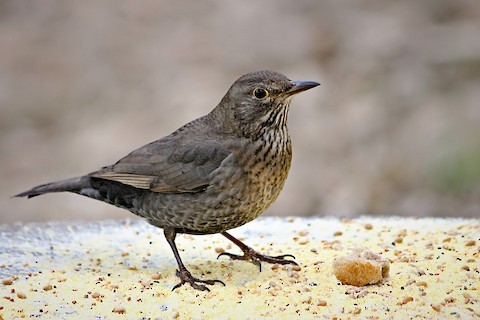
Common Blackbird, immature female. (Maksimir Park, Zagreb, Croatia; February 13, 2011.) © Bojan Bencic
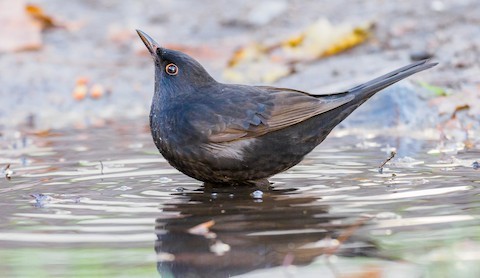
Common Blackbird, immature male, showing dark bill. (Lauttasaari Vattuniemenkatu, Uusimaa, Finland; November 24, 2020.) © Matti Rekilä
Juveniles are usually brown overall and streaked and spotted above and below, but vary widely in shade from pale grayish-brown to warm-brown to blackish
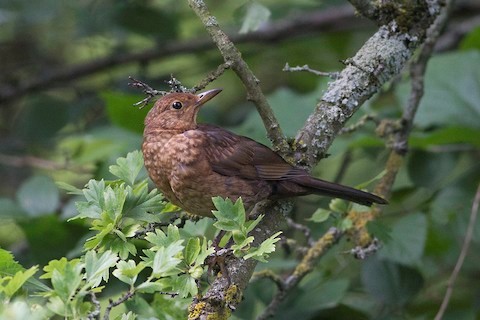
Common Blackbird, juvenile with warm-brown coloration. (Prinz-Emil-Garten, Darmstadt, Essen, Germany; July 7, 2022.) © Korkut Demirbas

Common Blackbird, juvenile with blackish coloration and heavily spotted underparts. (Sierra de Izco, Navarra, Spain; July 30, 2021.) © Josep del Hoyo
Notes
Polytypic species consisting of seven recognized subspecies. Formerly considered conspecific with the Chinese Blackbird (mandarinus), Tibetan Blackbird (maximus), and Indian Blackbird (simillimus).
More Images of the Common Blackbird
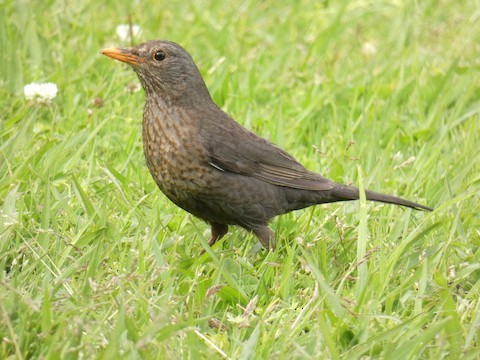
Common Blackbird, female. (Parque da Moita, Baixa da Banheira, Setúbal, Portugal; April 9, 2019.) © Nuno Lucas

Common Blackbird, female with pale plumage and a rusty tinge on the chest. (Mittenwald, Germany; June 12, 2009.) © Christoph Moning
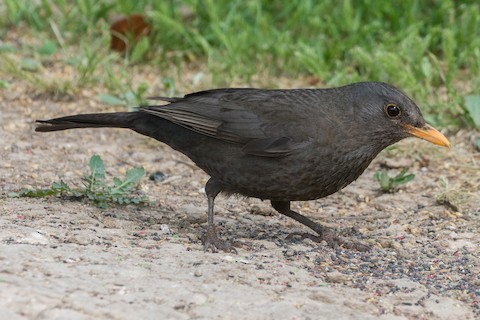
Common Blackbird, female with dark grayish-brown coloration. (Cerro del Telégrafo, Rivas-Vaciamadrid, Spain; May 12, 2021.) © Juan Miguel Artigas Azas

Common Blackbird, female with blackish-brown coloration. (Northwich, Cheshire, England; July 30, 2017.) © Davey Walters

Common Blackbird, female with pale-brown coloration. (La Montanera, Alcublas, Valencia, Spain; January 12, 2022.) © Rafa Muñoz
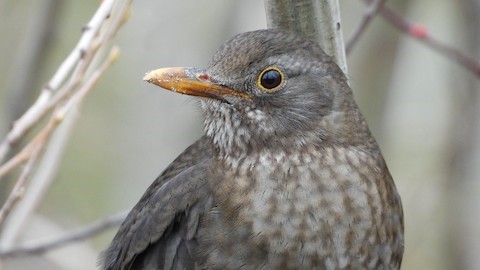
Common Blackbird, female. (Madrid, Spain; January 29, 2021.) © Manuel García Ruiz

Common Blackbird, T. m. intermedius, female—likely immature, judging from the bill color. (Almaty, Kazakhstan; January 22, 2017.) © Altay Zhatkanbayev
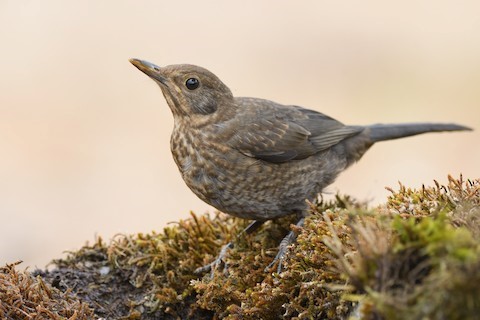
Common Blackbird, juvenile. (Los Prados, Ronda, Málaga, Andalucía, Spain; June 21, 2022.) © Santiago Caballero Carrera

Common Blackbird, juvenile with reddish-brown coloration. (Glückaufpark, Gelsenkirschen-Nord, Germany; July 22, 2022.) © Andreas Heikaus

Common Blackbird, juvenile with blackish coloration. (Sierra de Alcubierre, Huesca, Aragón, Spain; July 31, 2021.) © Josep del Hoyo

Common Blackbird, T. m. intermedius, juvenile. (Dushanbe, Tajikistan; July 29, 2022.) © Philip Steiner

Common Blackbird, leucistic male. (Zbraslav, Prague, Czechia; March 25, 2021.) © Honza Grünwald
References
BirdLife International. 2016. Turdus merula. The IUCN Red List of Threatened Species 2016: e.T103888106A87871094. https://dx.doi.org/10.2305/IUCN.UK.2016-3.RLTS.T103888106A87871094.en. (Accessed October 11, 2022.)
eBird. 2022. eBird: An online database of bird distribution and abundance. Cornell Lab of Ornithology, Ithaca, N.Y. http://www.ebird.org. (Accessed October 11, 2022.)
Mullarney, K., L. Svensson, D. Zetterström, and P.J. Grant. 1999. Birds of Europe. Princeton University Press.
Pizzey, G., and F. Knight. 2012. The Field Guide to the Birds of Australia. HarperCollins, New York.
Armitage, I. 2022. Eurasian Blackbird. In New Zealand Birds Online (Miskelly, C.M., ed.). https://nzbirdsonline.org.nz/species/eurasian-blackbird. (Accessed October 11, 2022.)
Xeno-Canto. 2022. Eurasian blackbird | manu pango – Turdus merula. https://xeno-canto.org/species/Turdus-merula. (Accessed October 11, 2022.)
